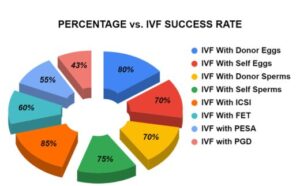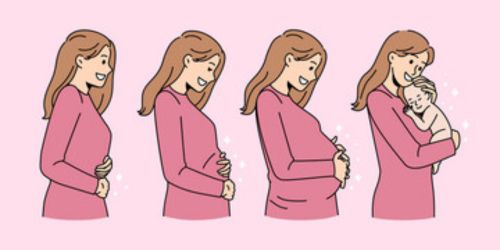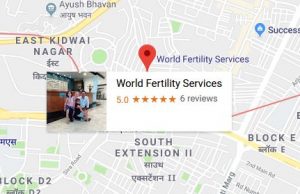Natural IVF cycles usually have a success rate of 10% to 15% per cycle, depending on the patient’s age and general fertility health. Instead of using strong hormonal stimulation to create several eggs, natural IVF is a less invasive method that depends on one egg being naturally selected during a woman’s menstrual cycle.
The chances of success are often lower because fewer eggs are extracted, which limits the number of embryos available for fertilization and transfer, even if this approach is less expensive than traditional IVF and lowers the risks associated with ovarian hyperstimulation syndrome (OHSS).
The natural IVF Cycle success rates of may be marginally greater for younger women with regular ovulation cycles and a healthy ovarian reserve. However, the likelihood of success is lower for women over 35 or those with certain reproductive issues. Patients who are considering natural IVF should speak with a reproductive doctor to determine whether it is the best course of action for their unique situation.
What Are The Advantages Of Natural IVF Cycle Success Rate?
Compared to standard IVF, the benefits of a natural IVF cycle include simplicity, less medical intervention, and fewer expenses. Instead of using large dosages of hormonal drugs, the goal of a natural IVF cycle is to extract the one egg that the body naturally selects during a woman’s menstrual cycle. By using this method, the likelihood of ovarian hyperstimulation syndrome (OHSS) and other adverse consequences from hormone injections is reduced.
Because it makes use of the body’s natural mechanism, natural IVF is especially advantageous for women who have limited ovarian reserve or who do not respond well to hormonal stimulation. Additionally, many patients find the surgery to be less emotionally and physically taxing due to the decreased need for drugs. Additionally, it is a less expensive choice.
Can You Do IVF With A Natural Cycle?

As an alternative to traditional IVF, it is possible to perform IVF using a natural cycle. IVF in a natural cycle uses little to no fertility drugs to stimulate the ovaries. Rather, the procedure concentrates on obtaining the lone egg naturally generated over a woman’s menstrual cycle. The resulting embryo is then returned to the uterus after fertilizing the egg in a lab. The natural cycle Women who have regular ovulation cycles, are responsive to fertility drugs, or have a poor ovarian reserve—where only one or two eggs may be accessible regardless of stimulation—are especially good candidates for IVF. In comparison to traditional IVF, it has a decreased risk of ovarian hyperstimulation syndrome (OHSS), fewer side effects, and lower expenses.
However, success rates may be impacted because there is a decreased probability of producing a viable embryo since fewer eggs are recovered. To find out if natural cycle IVF is a good fit for their medical condition and reproductive objectives, women who are thinking about it should speak with a fertility doctor.
Which Cycle Of IVF Is Most Successful?
Individual factors like the woman’s age, the quality of her eggs, the health of her sperm, and the underlying cause of her infertility can all affect how well an IVF cycle goes. For most couples, the first two or three IVF rounds are thought to be the most effective.
According to studies, the cumulative success rate rises with each extra cycle, so even if the first cycle doesn’t work out, a healthy pregnancy could still result from later cycles. Because their eggs are of superior quality, younger women (those under 35) usually have higher success rates in the early cycles. Cycles including methods like donor egg use or preimplantation genetic testing (PGT) may increase success for older women or those with reproductive issues.
Every IVF doctors in India gives important information on how the body reacts to therapy, enabling them to make the necessary corrections for subsequent cycles. The likelihood of success for any given cycle can be increased by speaking with a fertility professional to customize the protocol to the needs of the person.
What Is The Success Rate Of IVF For 40 Years Olds?

Depending on personal characteristics including general health, ovarian reserve, and egg quality, the success rate of IVF for women over 40 usually varies between 10% and 20% per round. Fertilization and embryo development are impacted by the normal decrease in egg quantity and quality that occurs as women age.
One of the main causes of the lower IVF success rates in India, this age group is this decline. Many women over 40 use assisted reproductive methods, such as preimplantation genetic testing (PGT) or intracytoplasmic sperm injection (ICSI), to increase the likelihood of successful transfer of viable embryos. Additionally, some could think about using donor eggs, which can greatly raise success rates to 50% or more per cycle.
Working together with a fertility professional to develop a personalized treatment plan is crucial for women in this age range. The likelihood of a successful pregnancy can be increased with the use of cutting-edge reproductive procedures and early intervention.
Which Month Is Good For IVF Treatment?
Since the effectiveness of IVF is mostly dependent on the woman’s age, general health, ovarian reserve, and the clinic’s level of experience, there is no one “best” month for the procedure. However, depending on their schedules, preferred climates, or emotional preparedness, some couples would rather begin IVF during specific months.
For instance, some people may find cooler months more comfortable because they experience less physical strain from the heat, particularly in warmer climates. Furthermore, some months might fit in better with lifestyle considerations, such as fewer work obligations, adequate rest, and treatment attention.
Ultimately, the best time for IVF is when the individual or couple feels physically, emotionally, and financially prepared. Consulting with a fertility specialist to align the treatment schedule with the woman’s menstrual cycle and other health factors is crucial for optimizing success rates.
Final Wording – Natural IVF Cycle Success Rate
We declare all essential points in the upper case of the content, now you have to read all significant elements that will assist to enhance the chances of success rate in your infertility treatment to conceive a baby naturally. We also recommend you grab the best IVF clinic in India, for instance, www.worldfertilityservices.com where you can find the latest updated articles to increase your medical knowledge to understand how IVF treatment is performed in India. We’re glad to provide all to share with you.
Frequently Asked Questions – Natural IVF Cycle
Do doctors freeze embryos in natural IVF Cycles?
Doctors can freeze embryos from natural IVF cycles, but it totally depends on the quality and development of each embryo. When it comes to the freezing of eggs, experts say natural IVF means less quantity of eggs, so you will not always get embryos that are not good enough to freeze every time.
How many cycles are safe and recommended to get Pregnant?
Yes, it is safe to go multiple IVF cycles, but most of the time, doctors recommend around three to six natural IVF cycles. That is the ideal range, and it helps to enhance your chances of getting pregnant without the risks of overstimulation. As a patient goes under multiple cycles, you can collect more embryos, which usually helps you to get a higher chance of pregnancy.
Table of Contents



 WhatsApp us
WhatsApp us